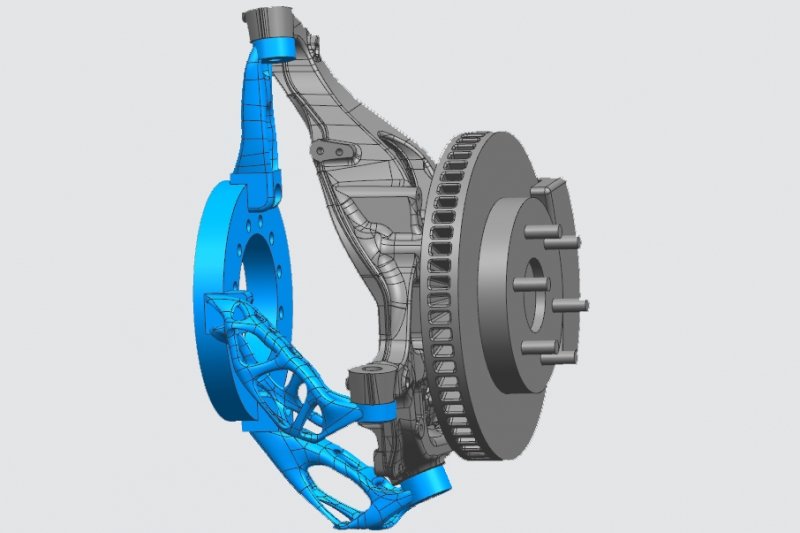201—Medical Device Ball Bearing Temperature Test Fixture
Our team is tasked with improving the repeatability and accuracy of the Medical Device Ball Bearing Temperature Test Fixture, provided to us by Stryker, confirmed through Gage R&R testing. The thermal performance results from the fixture are used to verify and choose the best ball bearing to use within various Stryker devices.
202—Radiofrequency Ablation Modeling and Validation of Cannula Designs
Lesion formation caused by radiofrequency (RF) ablation must be placed in a precise location by medical professionals to be effective in killing nerve cells. Our goal is to increase the thermal profile around the needle to allow medical professionals to be less precise in their placement of the cannula. The heat spread of the cannula can be modified through alteration of the insulation properties and the overall design of the needle.
203—Airport Needs Design Challenge
Our project goal is to reduce the contamination of deicing fluid in small airports. We developed a cart specially designed to capture deicing fluid. The fluid is primarily sprayed on the wings of the aircraft. This cart will help collect a significant amount of the fluid that comes from the wings. We will be creating a prototype, which is approximately a one-third model of the final design.
204—Vehicle Body Structure Component Design Using Pultrusion
Our project involves researching current body structure components in present-day passenger vehicles and light-duty trucks, identifying potential applications and systems, then designing and prototyping a replacement part to demonstrate performance and functionality. We determined that truck bed cross members were the best application.
205—Digital Engineering Tool for Impact Assessment in Rack Based EPS Systems
Our team was tasked to create a dynamic simulation of a rack based electric power steering system, from Nexteer Automotive, undergoing a standard in-house impact test. This simulation is required to take in available parameters of the rack geometry and test options and return position and force information of different sub-components. The goal is to be able to test component designs prior to prototyping and enable optimization of the steering rack performance.
206—Intraoperative EMG Waveform Identification
Our proposed design accurately identifies true electromyography (EMG) responses and differentiates them from surrounding noise, limiting false responses. The feedback system will provide the surgeon with real-time evaluation of the procedure via a simple system of audio tones to direct immediate steps following application of the signal. Audio tones will signal compression and proximity to a nerve, notifying the surgeon without need for additional knowledge of EMG analysis. The proposed solution will be a mixture of hardware and software approaches to amplify positive EMG responses and apply filters to reduce noise, with a simple warning system to eliminate the need for a specialist to interpret the EMG signal response.
207—Closed Loop Exhaust Aftertreatment Control System
Design and prototype an improved exhaust aftertreatment control system.
208—PLC Hardware in the Loop Simulation
The purpose of this design project is to decouple system testing from the physical machine. Production scheduling currently prohibits the ability to perform system testing in the physical test loop. Development of a virtual machine would alleviate these scheduling conflicts and provide tools for better testing and debugging of the molding machine.
209—Rapid Brake System Test Filtering

Design and implement a prototype fixture and its production process using an alternative means of design and manufacturing.
210—Michigan Tech Foundry Induction Furnace Ventilation Ring
Design and install a fume ring on the 300-lb. Inductotherm furnace in the Michigan Tech Foundry and connect into the existing ventilation system.
211—Pneumatic Flow Totalizer
Our team was tasked with designing a device that could totalize air flow to calculate cost of compressed air used by a machine. The device must measure 1-160 SCFM at 90 psi and be able to withstand pressures up to 125 psi. The team’s design utilizes two separate flow paths, one for low flow leak detection (1-10 SCFM) and one for high flow measurement (10-160 SCFM). Each flow path consists of its own orifice plate that is connected to a differential pressure transducer. The reading from the pressure transducer is used to calculate flow in a program on the HMI screen.
212—Hospital Washer Auto Sampler Usage & Data Optimization
Hospitals use wash systems to clean and sterilize instruments after use. Factors of the wash environments can harm surgical instruments. Our team designed a device that actively senses the conditions inside a hospital instrumentation washer. This device provides information for understanding the effects of the wash environment on medical instruments and will allow for wash cycle optimization.
213—Penetration Testing Course

To meet the need for new courses in the new Cybersecurity degree program, our team was tasked with developing a Penetration Testing course, which includes the business how-to as well as technical skills necessary to succeed in the field as a professional ethical hacker. We delivered a completed course, including a chosen course textbook, slides, an online lab set with accompanying lab manuals, and exams. GenCyber is a Michigan Tech summer program for local younger students. We provided instructional material, utilized Google Interland activities for younger students, and created the GenCyber camp curriculum to further develop and improve this course—another step toward the future of cybersecurity.
214—Automation of ISO 10555-1 Intravascular Catheter Corrosion Test
The CONVEY Guiding Catheter is designed to provide a pathway through which therapeutic and diagnostic devices are introduced in the coronary or peripheral vascular system. The US Food and Drug Administration released a new standard outlining the intravascular catheter corrosion test method required to determine the corrosion resistance, stating that any metallic components intended for fluid path contact must show no signs of corrosion when tested. In current practice, Boston Scientific manually performs the required test process throughout a three-day period, as there is no commercial product available, limiting the company’s productivity and flexibility. Our team was tasked with designing an objective, robust, and repeatable machine to perform the intravascular catheter corrosion test in an automated manner with continuous electronic measurements and data recording.
215—Ground Force Commander Simulation
Our team is developing an Android app to aid in the training of Ground Force Commanders. Our app will be a sandbox style simulation that puts a Ground Force Commander instructor in an online lobby with a trainee. The instructor will be able to define a scenario for the trainee to run through, using elements such as a drag-n-drop menu and chat box.
216—Use of Patient-Specific Geometry to Improve Interventional Structural Heart Procedures
Comparing the efficacy of open source 3D segmentation and modeling software to an approved payware software. Specifically, the use of patient CT scans converted to 3D models using 3D Slicer and Autodesk Meshmixer and 3D printed. 3D printed models allow the surgeon to predict the proper sized Watchman device to implant to the left atrial appendage (LAA) of the heart prior to procedure. Occlusion of the LAA reduces the risk of stroke in patients with atrial fibrillation.
217—Cloud Computing Cost Analysis

Our team compared the cost of running services in a cloud environment between the three largest service providers: Amazon Web Service, Google Cloud Platform, and Microsoft Azure.
218—Ice Resurfacing Machine
Our team designed and built an ice resurfacing machine that can be pulled by hand or behind a lawn tractor and will be used on personal ice rinks.
219—Extrusion Press Shear
We designed and built fixtures for stabilizing the carriage and tooling associated with the extrusion press in order to produce a clean shear of impure materials at the end of an extrusion. Our main goal is to produce sturdy mounts that are easy to operate and will not add unnecessary safety concerns when working around hot material. The solution must be designed and analyzed for stress concentrations as we will be working with high-output hydraulic rams.
















